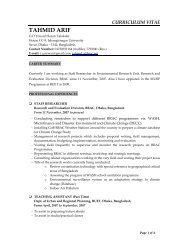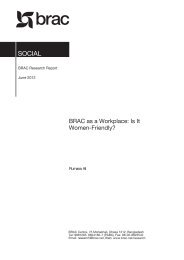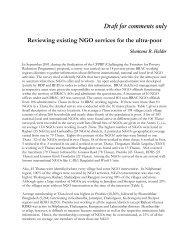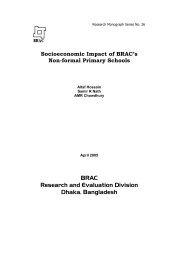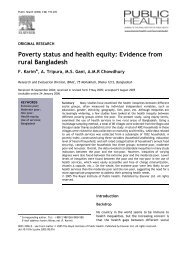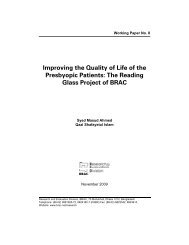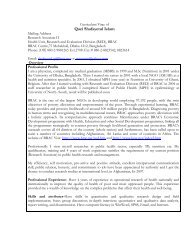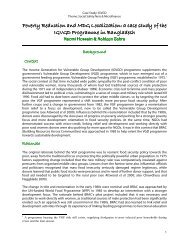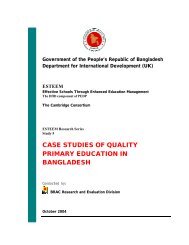Combining health and social protection measures to reach the ultra ...
Combining health and social protection measures to reach the ultra ...
Combining health and social protection measures to reach the ultra ...
Create successful ePaper yourself
Turn your PDF publications into a flip-book with our unique Google optimized e-Paper software.
Research resources<br />
compounds from many different sources even if <strong>the</strong>re is no<br />
interested industry partner <strong>and</strong> no commercial potential. This<br />
runs against <strong>the</strong> oft-stated maxims that only commercial<br />
market returns can catalyse drug development; <strong>and</strong> that only<br />
pharmaceutical companies (<strong>and</strong> perhaps only large<br />
multinational companies) have <strong>the</strong> requisite experience <strong>to</strong><br />
manage <strong>the</strong> lengthy, complex <strong>and</strong> expensive process of drug<br />
development.<br />
Equally important is that this flexible, modular approach<br />
not only allows but stimulates different (<strong>and</strong> often far<br />
cheaper) models of drug development. For example, by<br />
actively pairing small Western companies or academics with<br />
CROs <strong>and</strong> developing country manufacturers, PPPs create a<br />
neglected disease pipeline that encourages <strong>and</strong> allows<br />
smaller-sized groups <strong>to</strong> participate, <strong>and</strong> at a substantially<br />
lower cost than <strong>the</strong> traditional commercial approach. We note<br />
that <strong>the</strong> anti-malarial syn<strong>the</strong>tic peroxide has moved from<br />
labora<strong>to</strong>ry in<strong>to</strong> clinical at a cost of less than US$ 12 million;<br />
while <strong>the</strong> new fixed-dose antimalarial, pyronaridineartesunate,<br />
is expected <strong>to</strong> be registered for US$ 20 million or<br />
less. The TB Alliance also estimates that its anti-TB drug, PA-<br />
824, will cost less than US$ 90 million <strong>to</strong> complete clinical<br />
development. All <strong>the</strong>se projects involve academic, public<br />
domain or small company leads teamed up with contrac<strong>to</strong>rs<br />
or a developing country manufacturing partner. PPP codevelopment<br />
of multinational drug company leads can also<br />
be substantially cheaper, since costs of capital (estimated <strong>to</strong><br />
roughly double <strong>the</strong> cost of R&D) are largely avoided, <strong>and</strong><br />
companies are able <strong>to</strong> minimize <strong>the</strong>ir risk <strong>and</strong> financial<br />
outlays – <strong>and</strong> <strong>the</strong>refore <strong>the</strong>ir final prices. Ei<strong>the</strong>r or both of<br />
<strong>the</strong>se alternative approaches may provide interesting lessons<br />
for o<strong>the</strong>r Western diseases where <strong>the</strong> profit motive is weak or<br />
absent: antibiotics for drug resistant bacteria <strong>and</strong> products for<br />
orphan diseases are two examples that spring <strong>to</strong> mind.<br />
The upshot of <strong>the</strong>se different approaches <strong>and</strong> choices is<br />
that, as noted above, a great deal of PPP activity deviates<br />
markedly from <strong>the</strong> st<strong>and</strong>ard perception of what PPPs are <strong>and</strong><br />
how <strong>the</strong>y operate. It is true that many PPP deals, <strong>and</strong> <strong>the</strong><br />
majority of those with large multinational pharmaceutical<br />
companies, involve classical partnerships that are built on<br />
joint decision-making, majority funding from <strong>the</strong> PPP partner<br />
<strong>and</strong> in-kind donations of effort <strong>and</strong> skills from <strong>the</strong> private<br />
partner. Under <strong>the</strong>se deals, <strong>the</strong> PPP can be very much <strong>the</strong><br />
weaker party, since it relies on <strong>the</strong> charitable or strategic<br />
motivations of its private partner, which may change with <strong>the</strong><br />
next merger or acquisition. However, an equally large number<br />
of PPP deals do NOT look like this, particularly when <strong>the</strong> PPP<br />
has control over <strong>the</strong> R&D process or <strong>the</strong> background IP.<br />
Indeed, <strong>the</strong>se deals may have nei<strong>the</strong>r joint decision-making,<br />
in-kind donations nor private input – <strong>and</strong> may not even<br />
involve partnerships at all.<br />
The net effect of <strong>the</strong>se new models, approaches <strong>and</strong><br />
dynamics is that <strong>the</strong> new PPP product development<br />
organisations are, in many ways, PPPs in name only. By<br />
lumping <strong>the</strong>m <strong>to</strong>ge<strong>the</strong>r under a generalized “partnerships”<br />
umbrella that encompasses everything from charity <strong>to</strong><br />
business-funded <strong>health</strong> programmes, we risk failing <strong>to</strong><br />
underst<strong>and</strong> – <strong>and</strong> <strong>the</strong>refore capitalize on – <strong>the</strong> very specific<br />
strengths <strong>and</strong> opportunities that <strong>the</strong>se groups offer. In this<br />
context, we note particularly <strong>the</strong>ir ability <strong>to</strong> deliver high<br />
<strong>health</strong>-value new drugs <strong>to</strong> neglected disease patients, <strong>the</strong>ir<br />
capacity <strong>to</strong> reduce costs <strong>and</strong> risks <strong>to</strong> industry <strong>and</strong><br />
governments, <strong>and</strong> <strong>the</strong>ir catalytic role in translating basic<br />
in<strong>to</strong> applied research even in <strong>the</strong> absence of a<br />
commercial market.<br />
Challenges<br />
The first challenge is <strong>to</strong> provide policy-makers <strong>and</strong><br />
government donors with a better differentiated underst<strong>and</strong>ing<br />
of PPPs generally, <strong>and</strong> a far better underst<strong>and</strong>ing of what<br />
product development PPPs are <strong>and</strong> how <strong>the</strong>y operate – <strong>and</strong><br />
perhaps a better name for <strong>the</strong> PDPPPs.<br />
The second is <strong>to</strong> urgently encourage governments <strong>to</strong><br />
translate this underst<strong>and</strong>ing in<strong>to</strong> policies that support <strong>the</strong>se<br />
product development organizations, in particular policies that<br />
specifically encourage <strong>and</strong> reward industry involvement in<br />
<strong>the</strong>se groups (no such policies now exist) <strong>and</strong> new funding<br />
streams <strong>to</strong> address <strong>the</strong> noticeable, even embarrassing, lack of<br />
public funding for <strong>the</strong>m, despite <strong>the</strong> fact that <strong>the</strong>y are now<br />
responsible for three quarters of all neglected disease drug<br />
development. Fur<strong>the</strong>r, industry policies need <strong>to</strong> be tailored <strong>to</strong><br />
suit different industry groups: not only multinational drug<br />
companies, but also <strong>the</strong> smaller biotechs <strong>and</strong> CROs who are<br />
playing an increasingly active role.<br />
PPPs also face internal challenges, <strong>the</strong> greatest – but not<br />
<strong>the</strong> only one – of which is <strong>the</strong>ir funding gap. Even <strong>the</strong> bestperforming<br />
PPP cannot continue <strong>to</strong> contract <strong>and</strong> pursue R&D<br />
projects in <strong>the</strong> face of funding deficits of up <strong>to</strong> 50% in <strong>the</strong><br />
near future. PPPs are also not all <strong>the</strong> same, with some<br />
performing better than o<strong>the</strong>rs. While much of this reflects <strong>the</strong><br />
varying difficulty of <strong>the</strong> different disease targets <strong>the</strong>se groups<br />
address, all PPPs never<strong>the</strong>less need <strong>to</strong> seek <strong>to</strong> match industry<br />
levels of efficiency <strong>and</strong> productivity if <strong>the</strong>y are <strong>to</strong> secure funds<br />
from risk-averse public donors. This is likely <strong>to</strong> require not<br />
just public <strong>health</strong> expertise, but also high in-house levels of<br />
industry expertise <strong>and</strong> underst<strong>and</strong>ing, including through <strong>the</strong><br />
composition of Scientific Committees, Boards <strong>and</strong> staff; <strong>and</strong><br />
<strong>the</strong> willingness (<strong>and</strong> funds) <strong>to</strong> contract in <strong>the</strong> necessary skills<br />
when gaps become apparent. For instance, Medicines for<br />
Malaria Venture (MMV), which already has high levels of inhouse<br />
skills, has readily moved <strong>to</strong> secure CRO assistance on<br />
individual projects <strong>to</strong> maintain <strong>the</strong>ir performance st<strong>and</strong>ards.<br />
Industry, likewise, has challenges <strong>to</strong> address, in particular<br />
multinational drug companies who have more flexibility <strong>to</strong><br />
participate than do many smaller enterprises. Although four<br />
of <strong>the</strong> <strong>to</strong>p twelve multinational companies now have active<br />
neglected disease programmes collectively employing over<br />
200 scientists, o<strong>the</strong>rs do little or nothing in terms of neglected<br />
disease R&D. Those companies with modest activity could<br />
review whe<strong>the</strong>r this could be increased – <strong>and</strong> in particular<br />
whe<strong>the</strong>r partnering could offer a lower-risk, more costeffective<br />
way of pursuing greater activity. On <strong>the</strong> o<strong>the</strong>r h<strong>and</strong>,<br />
companies with little or no in-house expertise in infectious or<br />
veterinary diseases – who are likely <strong>to</strong> be unwilling, <strong>and</strong><br />
perhaps unsuited, <strong>to</strong> full-blown neglected disease R&D – can<br />
also take up <strong>the</strong> challenge by contributing creatively in o<strong>the</strong>r<br />
144 ✜ Global Forum Update on Research for Health Volume 4




